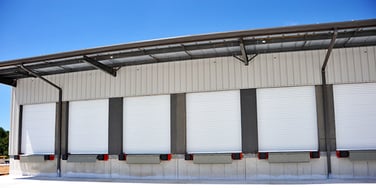DBCI Blog
The Power of Innovation. The Strength of Commitment. Steel roll-up door tips, tricks and industry updates from DBCI.
What’s in a Metal Roll-Up Door? Commercial Roll-Up Door Components
In this post, we will look at the commercial roll-up door components and the features that make metal roll-up doors so attractive for commercial, industrial, and institutional buildings.
Designing and specifying the right roll-up door for a particular building or usage directly depends on understanding the components options available, including the following:
Door Curtain:

The metal curtain is the basic barrier between the spaces on either side of the door. While most are made of steel that is corrugated for strength, the curtain should be selected to match the needs of the building and its location. For example, light-duty commercial doors can be the most appropriate choice for buildings where the doors are not subject to harsh conditions or used as frequently, such as recreational storage buildings and auto body shops. Conversely, heavy-duty door curtains are most appropriate industrial conditions where high frequency of use is anticipated, such as warehouses or freight buildings.
For buildings with door openings subject to wind exposure, wind-rated doors are a must as they can dramatically reduce maintenance and replacement costs and minimize downtime often experienced as a result of extreme weather. Watch this video to see DBCI’s 5,000 Series wind-certified door as it withstands wind speeds exceeding 215 mph during an independent test for wind certification.
Axle-Drum Assembly:

Commercial door curtains hang down from, and are rolled up onto, a horizontal axle and drum located above the door. This assembly is critical to the smooth operation of the door, and includes tension springs and other hardware that enable the curtain to be moved readily and properly.
Saddle Clamps:
The axle-drum assembly is mounted onto a supporting piece of structural steel through the use of saddle clamps. Single-piece saddle clamps are preferred over two-piece components, since they facilitate easy adjustment of the tension on the system, provide great durability and are easy to install.
Guides:
As the curtain moves up or down from the axle-drum assembly, it needs to be directed along the face of the wall opening. This is accomplished with pre-formed guide tracks mounted to the wall on either side of the door. Because the guides are exposed when the door is open, impact resistance and durability are particularly important. DBCI has responded with our proprietary Super Polymeric Impact-Resistant Door Rail (SPIDR) Guide system that is designed to keep doors up to 10 feet tall operating and functional, particularly in heavy-duty environments.
Spacer:
The operation of the door can be performed manually with a chain system that requires a spoked wheel supported by a spacer. One-piece aluminum spacers are preferred for this function as they are durable, corrosion-resistant, and install quickly and easily with only three screws.
Motor Operators:
In cases of frequent usage, electric motor operation of commercial doors is often desired. Using electric motors designed specifically for roll-up doors increases the ease of day-to-day operations and makes them more likely to hold up over time.
Additional Options:
Commercial door curtains can also be insulated for exterior wall locations or where sound deadening and/or climate control is required. Also available are vision panels located at appropriate heights and axle-drum housing covers that provide protection and cleanliness.
For more information on commercial roll-up door components, be sure to consult the product manufacturer for application, installation and maintenance instructions, as well as for information on warranties. For full details on DBCI commercial roll-up doors and components, contact your local DBCI representative.